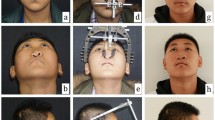Abstract
Background
Distraction osteogenesis is a standard method for craniosynostosis. However, the technique using conventional devices still has some disadvantages, especially for anterior or posterior plagiocephaly with complex deformities. In the Nakajima’s angle-variable internal distraction (NAVID) system originally for maxillary surgeries, the cranial three-dimension (D) distractor with three dimensionally movable joint at the anterior arm has been developed recently in order to prevent the interference in the distraction process and excessive force.
Case reports
In this paper, we first reported two cases of anterior plagiocephaly, and one case of posterior plagiocephaly received distraction osteogenesis using new 3-D distractor in the NAVID system. In two cases of anterior plagiocephaly, the reshaping of supra-orbital bar in reference of simulating by the 3-D skull model was performed. In all cases, we fixed two paralleled 2-D distractors and a 3-D distractor in the upper frontal or parietal region.
Conclusion
Within the limitations of this study, we believe that the NAVID system is suitable for infant plagiocephaly due to the simple and small joint arm. Furthermore, the usage of the 3-D distractor would reduce the interference with 2-D distractors and easily lead to attainment of targeted distracting distance.




Similar content being viewed by others
References
Yamashita M, Akai T, Kishibe M, Shimada K (2015) One-piece bone flap osteotomy using thread wire saw for fronto-orbital advancement with distraction osteogenesis in craniosynostosis. Childs Nerv Syst 31:279–283. doi:10.1007/s00381-014-2554-9
Hopper RA (2012) New trends in cranio-orbital and midface distraction for craniofacial dysostosis. Curr Opin Otolaryngol Head Neck Surg 20:298–303. doi:10.1097/MOO.0b013e3283543a43
Nowinski D, Di Rocco F, Renier D, Sainterose C, Leikola J, Arnaud E (2012) Posterior cranial vault expansion in the treatment of craniosynostosis. Comparison of current techniques. Childs Nerv Syst 28:1537–1544. doi:10.1007/s00381-012-1809-6
Akai T, Iizuka H, Kawakami S (2006) Treatment of craniosynostosis by distraction osteogenesis. Pediatr Neurosurg 42:288–292. doi:10.1159/000094064
Nakajima H, Sakamoto Y, Tamada I, Ohara H, Kishi K (2012) An internal distraction device for Le Fort distraction osteogenesis: the NAVID system. J Plast Reconstr Aesthet Surg 65:61–67. doi:10.1016/j.bjps.2011.08.009
McCarthy JG, Schreiber J, Karp N, Thorne CH, Grayson BH (1992) Lengthening the human mandible by gradual distraction. Plast Reconstr Surg 89:1–8 discussion 9–10. doi:10.1097/00006534-199289010-00001
Hirabayashi S, Sugawara Y, Sakurai A, Harii K, Park S (1998) Frontoorbital advancement by gradual distraction. Technical note. J Neurosurg 89:1058–1061. doi:10.3171/jns.1998.89.6.1058
Sugawara Y, Hirabayashi S, Sakurai A, Harii K (1998) Gradual cranial vault expansion for the treatment of craniofacial synostosis: a preliminary report. Ann Plast Surg 40:554–565. doi:10.1097/00000637-199805000-00021
Nagasaka M, Kato M, Osawa H (2012) Classification and surgical management of syndromic and multiple suture craniosynostosis. Nerv Syst Child 37:307–317(Japanese)
Akai T, Shiraga S, Sasagawa Y, Iizuka H, Yamashita M, Kawakami S (2013) Troubleshooting distraction osteogenesis for craniosynostosis. Pediatr Neurosurg 49:380–383. doi:10.1159/000369029
Imai K, Komune H, Toda C, Nomachi T, Enoki E, Sakamoto H, Kitano S, Hatoko M, Fujimoto T (2002) Cranial remodeling to treat craniosynostosis by gradual distraction using a new device. J Neurosurg 96:654–659. doi:10.3171/jns.2002.96.4.0654
Conflict of interest
We did not receive any equipment, materials, or financial support from outside, to conduct this study. None of the authors has a financial interest in any of the products, devices, or drugs mentioned in this article.
Author information
Authors and Affiliations
Corresponding author
Rights and permissions
About this article
Cite this article
Osawa, H., Kato, M., Nagakura, M. et al. The usage of the three-dimension distractor in the NAVID system for plagiocephaly—three case reports. Childs Nerv Syst 31, 2387–2390 (2015). https://doi.org/10.1007/s00381-015-2817-0
Received:
Accepted:
Published:
Issue Date:
DOI: https://doi.org/10.1007/s00381-015-2817-0




